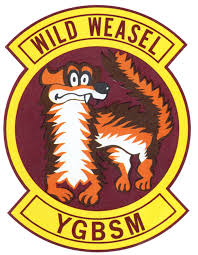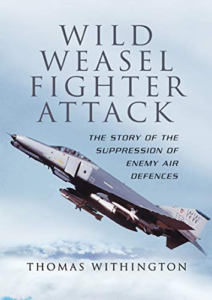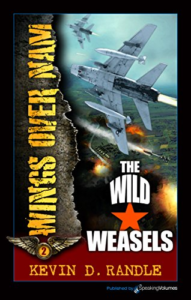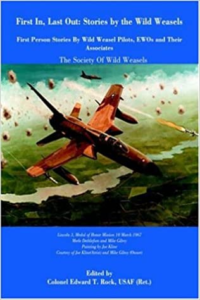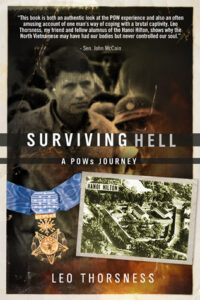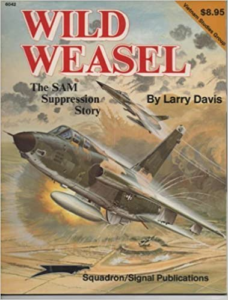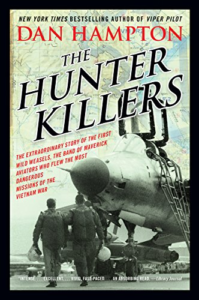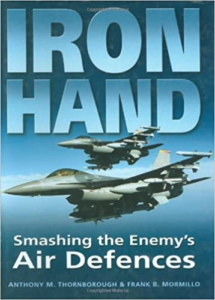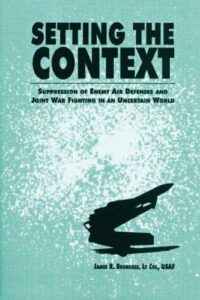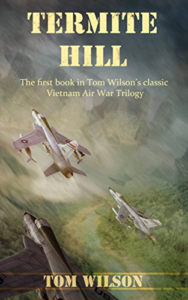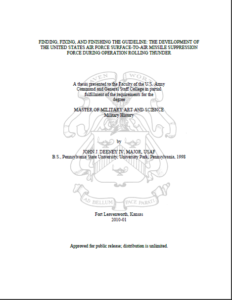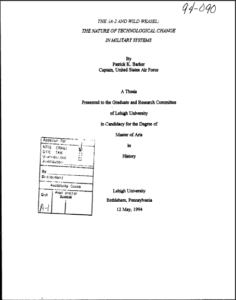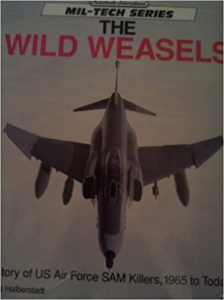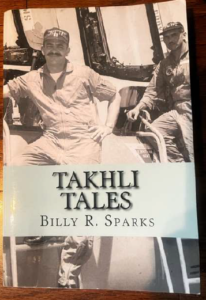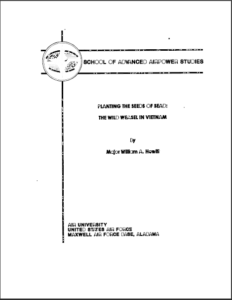Books on the Wild Weasels
Books:
- Wild Weasel Fighter Attack
- The Wild Weasels (Wings Over Nam)
- First In, Last Out
- Surviving Hell
- Wild Weasel: The SAM Suppression Story
- The Hunter Killers
- America’s White Table
- Iron Hand
- Takhli Tales
Book Available for Free:
Detecting and destroying enemy Surface-to-Air Missiles (S.A.M.) and radar is arguably the most dangerous mission that any pilot can undertake. Tactics differ with air forces, but the general principal is to fly a formation of aircraft into an area where the enemy s air defenses are strong, wait for their radar to illuminate the aircraft and then launch a volley of anti-radiation missiles to destroy the radar and thus blind the S.A.M. and air defenses. Put simply, without the Suppression of Enemy Air Defences (S.E.A.D.) mission, the loss of other aircraft will be too high and the effectiveness of attack on the enemy too low.Despite the undeniable bravery of the aircrews who flew these missions for the United States Air Force in every conflict since the Vietnam war, and their colleagues in other air forces across the world who have risked their lives in similar missions, the tactics, history, aircraft and weapons of the S.E.A.D. mission have seldom benefited from rigorous historical examination. Using interviews with S.E.A.D. pilots, industrial experts and historical documents this book for the first time will give a detailed history of the S.E.A.D. mission from the Vietnam War to the present day.”
Every pilot knew the NVA was building radar-guided SAM missile sites, but Washington prohibited any strikes until the death rockets were up and blowing American fliers to pieces. At the Gunfighter’s Club in Saigon the cold beer, blaring rock ‘n’ roll, and bare-assed girls can’t wash away the bitterness, and Air Force Major William Taylor knows that something has to be done fast. What he doesn’t know is that stateside, a bunch of green volunteers are testing a modified F-100 fighter. Their mission: learn to fly their killing machines into the very teeth of the NVA missile sites—and destroy them. Their code name: the Wild Weasels. When the untested, undertrained Weasels arrive in country, Major William Taylor will be the first to join them in the blood-red skies of Vietnam—for a death-defying mission of revenge.
Ed Rock brings the reader Wild Weasel Stories from more than 40 authors, mostly Wild Weasel pilots and Electronic Warfare Officers (EWOs). These are the true, first person, accounts written by the men whose primary mission was, and is today, to find, attack and destroy enemy Surface to Air Missile (SAM) sites and other radar directed weapons systems. They fly into the enemy heartland through skies filled with MiG fighters, SAMs, and Anti-Aircraft Artillery (AAA). Losses are heavy and courage and heroism are commonplace. The stories also include accounts by a cross section of Wild Weasel associates without whose support the mission could not have been successfully performed including a contractor, Flight Surgeon, Chaplain Maintenance technician, and the wife of a pilot killed in action (KIA). Some are shot down and rescued, others captured or killed, and many successfully complete their missions. All wonder if there will be a tomorrow. The stories take place in peace and war. Many are thrilling accounts of combat action, some are funny, others tragic, all are interesting. It is a moving testament to all Wild Weasels and their families especially to those that paid the ultimate price with courage and honor.
Thorsness joined the U.S. Air Force in 1951 at age 18 and became a jet pilot during the Vietnam War. During an 1967 mission he was shot down over North Vietnam. Injured and captured, he spent six years in the Hanoi Hilton. When the war ended in 1973, Thorsness was awarded the Congressional Medal of Honor. Surviving Hell is a harrowing story of captivity, as told by the man who lived it.
The Extraordinary Story of the First Wild Weasels, the Band of Maverick Aviators Who Flew the Most Dangerous Missions of the Vietnam War
The White Table is set in many mess halls as a symbol for and remembrance to service members fallen, missing, or held captive in the line of duty. Solitary and solemn, it is the table where no one will ever sit. As a special gift to her Uncle John, Katie and her sisters are asked to help set the white table for dinner. As their mother explains the significance of each item placed on the table Katie comes to understand and appreciate the depth of sacrifice that her uncle, and each member of the Armed Forces and their families, may be called to give. It was just a little white table… but it felt as big as America when we helped Mama put each item on it and she told us why it was so important. “We use a Small Table, girls,” she explained first, “to show one soldier’s lonely battle against many. We cover it with a White Cloth to honor a soldier’s pure heart when he answers his country’s call to duty.” “We place a Lemon Slice and Grains of Salt on a plate to show a captive soldier’s bitter fate and the tears of families waiting for loved ones to return,” she continued.”We push an Empty Chair to the table for the missing soldiers who are not here…”
Learn how military pilots protect themselves against an attack from a surface-to-air missile (SAM). This book describes the evolution of American anti-radar weapons, related jamming tactics and stealth technology as leading-edge countermeasures to the SAM and other sophisticated ground-based anti-aircraft defenses. The focus is on new weapons and tactics as they emerged in combat, beginning with the Vietnam War and later the Persian Gulf and Balkans conflicts. The text combines an analytical overview of the weapons systems mixed with first-hand anecdotal reminiscences from former air and ground crews.
Colonel Brungess proposes using joint suppression of enemy air defenses (JSEAD) to address the problem of reduced SEAD resources available to individual services. He contends that the demise of the Soviet Union presents the perfect transitional period for SEAD planners to create new approaches to countering the information-based integrated air defense system nets. He looks at the foundations and evolution of SEAD, identifies pertinent variables, and shows how they have changed. Colonel Brungess concludes that fiscal reality demands that the services forge joint SEAD tactics and doctrine.
North Vietnam, 1966. F-105 Thunderchiefs–and America’s elite corps of fighter pilots who fly them–are being shot down in startling numbers over the Vietnamese jungle by the greatest array of sophisticated weapons ever gathered in one area. To combat the deadly missiles, the Pentagon scrambles desperately for a way to turn the tide of war. Their answer: the Wild Weasel, a technological demon that brings with it a new highly dangerous mission for Lt. Col. Mack MacLendon’s 357th Tactical Fighter Squadron. Fighting their way through Soviet MIGs and SAMs, the courageous men of the squadron rise to the challenge, and suddenly an incredible air war has begun. The prize: the most heavily defended real estate on earth–and the lives of the men whose triumphs and tragedies will live on in their own special place in history.
During Operation Rolling Thunder, the United States Air Force was unprepared for the introduction of the SA-2 Guideline surface-to-air missile system into the North Vietnamese integrated air defense system IADS. Following a series of aircraft losses in the summer of 1965, the USAF identified an emerging time critical requirement for a dedicated SAM suppression capability. This thesis will provide background for USAF air operations during Rolling Thunder. Next this thesis will use the Find, Fix, Finish, Exploit, and Analyze F3EA targeting methodology as an interpretive model for analyzing the creation, fielding, and tactical employment of USAF Wild Weasel platforms. This thesis will then analyze the structure and effectiveness of the North Vietnamese IADS, and show how mobility tactics and integration drove the requirement for the Wild Weasel platform. This thesis will discuss the initial acquisition and development of the Wild Weasel program up to and including the Wild Weasel III platform F-105FG, and then will examine how the operations-intelligence cycle allowed US aircrew to refine their understanding of the capabilities of the North Vietnamese IADS, and its emerging tactics. This thesis will conclude with an assessment of the Wild Weasel program during Rolling Thunder, and recommendations for future offensive counter-air planning and execution.
This thesis examines how the US Air Force responded to the first combat firing of the SA-2 surface to air missile over North Vietnam in 1965. That response included the deployment of aircraft specifically designed to jam radars, the production of jamming pods for tactical fighters, borrowing the US Navy’s anti radiation missile, and the introduction of the unique Wild Weasel aircraft. Together, these technologies represented a nascent form of tactical electronic combat that helped the Air Force to regain control of the air over North Vietnam.This study reveals the complexity of adaptation through a ‘bottom-up’ look at the Wild Weasel I test program.
All AU Press publications are online and free to download: https://www.airuniversity.af.edu/AUPress/.
Print copies of AU Press publications are available at no cost to active duty, total force, retired military, libraries and research centers, and Department of Defense personnel and organizations. To order print publications, fill out the Contact Us form, e-mail us directly at AirUniversityPress@au.af.edu, or call 334-953-2773 (DSN 493). Please refer to the AU Press code number at the end of the full publication synopsis (e.g., B-155, CPP-2, AU-2). Please note, some publications are only available in electronic format.
